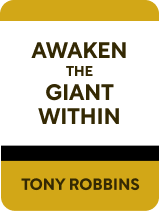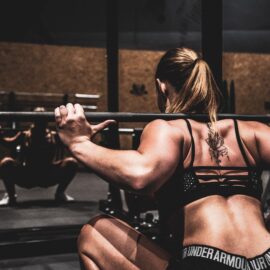

This article is an excerpt from the Shortform book guide to "Awaken the Giant Within" by Tony Robbins. Shortform has the world's best summaries and analyses of books you should be reading.
Like this article? Sign up for a free trial here .
What is Tony Robbins’ health advice? What steps can you take to improve your health today?
For Tony Robbins, health optimization is important if you want to change your life for the better. Target this area of your life to improve your mood, mindset, and well-being. The following Tony Robbins health advice can help you get on track with your fitness goals and improve your health.
Keep reading for the best Tony Robbins health advice.
Advice From Tony Robbins on Health
In this article, you’ll find some powerful healthy lifestyle tips from Tony Robbins. Fitness and health are important parts of your life and can influence everything from your mood to your confidence.
When it comes to your physical vitality, the first and most important thing to understand is that there is a difference between fitness and health:
- Fitness refers to your physical ability to do something athletic.
- Health means that all of your physical systems are working optimally.
Fitness does not necessarily equate to health because, in pursuit of achieving the strength and stamina to perform an athletic activity, you can subject yourself to injury and fatigue, harming your overall health and wellness.
Step 1: Exercise Strategically
You can balance both health and fitness by strategically incorporating both aerobic and anaerobic exercise into your life, which trains your metabolism to burn fat, increases your energy levels, and improves your overall health. First, you need to understand the difference between aerobic and anaerobic exercise:
- Aerobic exercise is done at a moderate intensity—at which you can still talk—and is sustained for a longer period of time. This form of exercise builds your endurance and burns fat.
- Anaerobic exercise is done in short, intense bursts, which cause you to breathe so hard that it’s difficult to talk. This form of exercise builds your power and burns glycogen, a form of sugar.
By adjusting your pace and level of intensity, you can modify most exercises to make them either aerobic or anaerobic. However, in our culture, people tend to prioritize anaerobic exercise because they think that more intense workouts and higher heart rates create better results. On top of that, most people endure enough stress in their daily life that they are perpetually in a heightened, anaerobic state. Between their stressful lifestyles and their intense workouts, they burn through so much glycogen that their bodies have to start using blood sugar as fuel. This is a problem because your nervous system consistently needs two-thirds of your blood sugar, so when you start burning through it with too much anaerobic exercise, you can experience:
- Anxiety and depression
- Circulation problems
- Disorientation
- Fatigue
- Headaches
- Premenstrual syndrome
- Repeated injuries
- Stiff joints
Additionally, if you jump into an intense anaerobic workout without properly training and warming up, your body must supply blood to your muscles so quickly that it’s forced to reroute it from your liver, kidneys, and other critical organs. This deprives the organs of oxygen, which can weaken and damage them.
Step 2: Build an Aerobic Base and Incorporate Anaerobic Exercise
Fortunately, you can avoid the issue outlined above by building an aerobic base, which trains your body to burn fat as its primary fuel. To develop your aerobic system, start by doing only aerobic workouts for two to eight months. This will condition your metabolism, which:
- Promotes fat burning
- Boosts your energy
- Supports your immune system
- Minimizes your injuries
- Improves your endurance
If you already own or can buy a portable heart rate monitor, you can ensure that your heart rate doesn’t rise to anaerobic levels (greater than 180 minus your age). If you don’t have a monitor, gauge your intensity level on a scale of 0 to 10, with 0 being equivalent to sitting on the couch and 10 being so intense that you feel like your heart is about to explode. During an aerobic workout, try not to rise above a 7, ideally staying between 6 and 7.
Begin with three workouts like this each week:
- Gradually warm up for about 15 minutes. This gives the fatty acids stored in your body a chance to move into your bloodstream, where they can be used to fuel your workout (instead of your blood sugar). Additionally, this gives your body time to deliver blood to your muscles instead of quickly rerouting it from your organs. If you’re wearing a heart monitor, your heart rate should be about 50 percent of the maximum heart rate (your maximum heart rate is 220 minus your age).
- Exercise at an aerobic level for 20 to 45 minutes. If you’re wearing a heart rate monitor, your maximum aerobic level is 180 minus your age.
- Cool down for 12 to 15 minutes by walking or doing another easy movement. This helps blood circulate through your body to be cleansed and reoxygenated. If you skip your cool-down, your blood stays in the muscles you just worked out, which raises the toxicity in your bloodstream.
After building your endurance through an aerobic base, increase your power by adding anaerobic exercise. Anaerobic workouts increase your levels of human growth hormone (HGH), which:
- Stimulates growth of tissues, bones, and organs
- Improves muscle tone
- Increases lean mass
- Improves flexibility
- Builds muscles
Your body produces the hormone consistently until you’re about 30, after which point your natural HGH levels drop. However, anaerobic exercise raises your HGH, and it’s never too late to start: Research shows that people in their 60s who hadn’t done any muscle-toning exercise in more than a decade increased their muscle mass and energy levels through this kind of explosive anaerobic exercise.
The best time to introduce anaerobic exercise will be when you reach a plateau in your aerobic training—most likely after two to four months—but the ideal timing will be different for everyone. Above all, listen to your body. When you’re ready, incorporate anaerobic workouts into your regimen by adding in weight training and increasing the pace of your aerobic workouts. Aim to add one to three anaerobic workouts a week.
Step 3: Develop a Healthy Lifestyle
Research shows that if you maintain a consistent exercise routine for one year, it will become a lifelong habit. Although you may stray from this habit intermittently, the conditioning will be strong enough to pull you back every time.
If you associate pain with exercise, use the strategies we’ve discussed throughout the book to retrain your mind to associate it with pleasure. Find ways to enjoy your workout—you can even incorporate another activity into your warmup, such as:
- Watching the news
- Listening to podcasts or audiobooks
- Going through your list of power questions
- Reviewing your values and rules hierarchies
Additionally, ensure that your nutrition properly fuels your exercise. Don’t undereat or cut out too much fat from your diet, because this causes your body to store fat as a means of survival—your body assumes there is a food shortage, and that it must hold onto everything it can. Furthermore, if you do undereat for a while, your body stays in fat-storage mode even after you resume eating your normal quantity, causing even more weight gain.
Exercise: Optimize Your Physical Health
The following Tony Robbins health exercise will help you put the advice from this article into practice. Increase your longevity and improve your quality of life by making a commitment to your physical health:
- Reflect on and internalize the difference between health and fitness.
- Commit to maintaining your health.
- Assess your current level of health. What are your current aerobic and anaerobic exercise routines (if any)? You’re exercising anaerobically if you answer yes to these questions: Do you generally wake up feeling tired? After exercising, are you ravenously hungry, do you have mood swings, and does your body ache? Do you have fat that just won’t go away despite your workouts?
- If you can, buy a portable heart-rate monitor.
- Starting immediately, follow the plan above to build an aerobic base.
- If you can, read the chapter titled “Energy: The Fuel of Excellence” from Robbins’s previous book, Unlimited Power.
The above Tony Robbins health optimization tips will help you to improve your health and fitness, putting you in a good position to improve the rest of your life.

———End of Preview———
Like what you just read? Read the rest of the world's best book summary and analysis of Tony Robbins's "Awaken the Giant Within" at Shortform .
Here's what you'll find in our full Awaken the Giant Within summary :
- How to make transformational changes to your life through small adjustments
- How you create your destiny every time you start a sentence with “I am…”
- Strategies to take control of your thoughts and emotions






